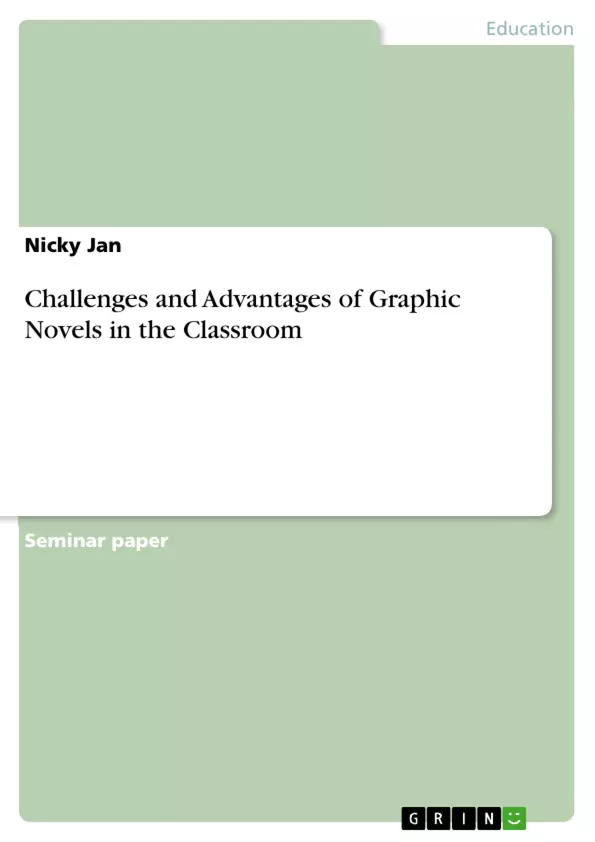In the following chapters definitions and a short scientific reflection on graphic novels are provided, as well as the research study poster and the book presentation which were conducted in the seminar.
Graphic novels – a term that is used diligently by educators, teachers, parents and their children in recent years. It is indisputable that graphic novels have an increasing fan base. One can find graphic novel supporters advocating the use of it as a new text format in the classroom and opponents who are taking a skeptical view towards graphic novels. I personally have never been a fan of comics or graphic novels, because I never really got in touch with them during my school career. "Graphic Novels and Research" was the second seminar about graphic novels I attended at university to enhance my knowledge and especially on how to use comics in the EFL classroom.
Graphic novels do not necessarily need text to be understood, the reader can freely interpret and analyze what the depicted story means to him. In the EFL classroom graphic novels should be used more often and well-considered, because students are animated to think about the content from another point of view. Some topics might be about sociology, history, gender or culture, many of those topics might be easier understood if adapted as a graphic novel. Students improve their reading competence, transcultural competence and their visual literacy. Hence, graphic novels are a creative, visualized way of approaching and teaching in the EFL classroom.
Inhaltsverzeichnis (Table of Contents)
- Introduction
- Definition of “Graphic Novels”
- Research Study Poster
- Book Presentation
- Scientific Reflection of Graphic Novels in the EFL classroom
- Advantages of Using Graphic Novels in the EFL classroom
- Challenges of Using Graphic Novels in the EFL classroom
- Motivating Learners for Reading Graphic Novels
- Seminar Reflection
- Bibliography
Zielsetzung und Themenschwerpunkte (Objectives and Key Themes)
This seminar paper aims to explore the use of graphic novels in the EFL classroom. It provides a comprehensive overview of the topic, including definitions of the term "graphic novel," a review of the research on their use in education, and a reflection on the author's personal experiences with graphic novels. The paper also discusses the potential advantages and challenges of using graphic novels in the EFL classroom, as well as strategies for motivating students to read them.
- Definition and characteristics of graphic novels
- The potential of graphic novels in EFL classrooms
- Motivating students to read graphic novels
- Research on the use of graphic novels in education
- Personal experiences with graphic novels and their pedagogical implications
Zusammenfassung der Kapitel (Chapter Summaries)
The first chapter introduces the topic of graphic novels and discusses their increasing popularity among educators and students. The second chapter provides a comprehensive definition of the term "graphic novel," highlighting the challenges of defining a term that is still evolving. The third chapter focuses on a research study poster, examining the motivations of students for reading graphic novels. Finally, the fourth chapter presents a scientific reflection on the use of graphic novels in the EFL classroom, exploring both the advantages and challenges of using this format.
Schlüsselwörter (Keywords)
The primary focus of this paper is on graphic novels and their use in the EFL classroom. Key terms and concepts include: graphic novels, comic books, sequential art, EFL, motivation, visual literacy, interdisciplinary learning, and research study.
- Citation du texte
- Nicky Jan (Auteur), 2017, Challenges and Advantages of Graphic Novels in the Classroom, Munich, GRIN Verlag, https://www.grin.com/document/488869



